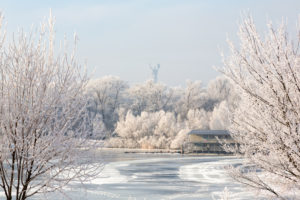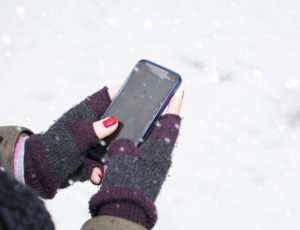Frostbite Treatment: Quick—and Smart—Action Required
Every year, frigid weather brings with it more cases of frostbite. Treatment should be quick in order to avoid serious consequences.
If you live or in a cold-weather climate, you’ve had experience “braving the elements.” And you also know that frigid weather is nothing to take lightly: The danger of frostbite is very real and can result in permanent damage, leading in severe cases to amputation. So at the first symptoms you experience, it’s important to take a number of frostbite treatment steps.
First, what is frostbite? By definition, frostbite is the “superficial or deep freezing of the tissues of some part of the body,” as Merriam-Webster describes. At highest risk, of course, are our most exposed areas (nose, ears, cheeks, chin) and our inadequately protected areas (particularly our hands, fingers, feet, and toes).
Wear layers of clothing (preferably waterproof on the outside), cover your face and ears, protect your hands with insulated gloves or mittens, and make sure your footwear is appropriate, with adequate insulation from socks. (See “How to Avoid Frostbite” sidebar below.)
Treating Frostbite: Fast Action Required
If you have symptoms of frostbite, seek quick medical care. If not available, the Centers for Disease Control and Prevention advises these six steps:
READY FOR WINTER?
Don’t let winter storms take you by surprise. As the weather turns, take into account the advice in this post at The Old Farmer’s Almanac: Are You Prepared for the Next Blizzard? 5 Tips for Weathering the Next Storm.
- Get into a warm room as soon as possible.
- If possible, do not walk on frostbitten feet or toes. Walking increases the damage.
- Put the affected area in warm—not hot—water.
- You can also warm the affected area using body heat. For example, use your armpit to warm frostbitten fingers.
- Don’t rub the frostbitten area with snow or massage it at all. This can cause more damage.
- Don’t use a heating pad, heat lamp, or the heat of a hair dryer, stove, fireplace, or radiator for warming. Since frostbite makes an area numb, you could burn it.
The website SkinSight.com recommends, as first aid treatment for cases of mild frostbite, moving to a warmer place, removing clothing from the affected area, and rewarming the affected area “until sensation in the skin has returned and the skin is soft (for at least 30 minutes). Rewarming of frostbitten skin is typically accompanied by pain, swelling, and color change.”
Frostbite Symptoms and How They Progress
Frostbite symptoms may begin with redness or pain to the affected area, plus a “prickling” feeling. This first stage is called “frostnip.” The CDC advises you, at the onset of such signs, to get out of the cold or to protect any exposed skin—frostbite may be beginning. (See “How to Avoid Frostbite” sidebar.)
The condition can quickly progress to “superficial” frostbite, where the redness in the affected area begins turning to a white or grayish-yellow color. At this point, ice crystals may form in your tissue and you may feel a warmess or even stinging feeling. Your skin then may begin feeling unusually firm or waxy and numb. In addition, blisters can begin appearing on frostbitten areas, especially on the hands or limbs.
WIND CHILL MATTERS
Pay attention not just to temperatures, but to wind chill factor. Wind chill is that “feels-like” temperature that factors in the strength and iciness of cold winds. According to Brian Donegan, digital meteorologist at The Weather Channel, “The wind strips away the thin layer of warm air above your skin. The stronger the wind, the more heat lost from your body, and the colder it will feel.” Bitterly cold wind chills can “increase your risk of developing frostbite and hypothermia.”
The National Weather Service (NWS) offers a chart that shows how long it takes for frostbite to set in at various temperatures. If the temperate is -5 degrees Fahrenheit, for example, a wind force of 15 mph makes the temperature “feel like” -26 degrees—and frostbite can result on exposed skin in 30 minutes. Click here to see the NWS chart.
If it progresses to the “severe frostbite” stage, all layers of the skin, including deep tissue, become affected. At this point, you’ll feel more numbness and a loss of sensation of cold or pain, and stiffening joints or muscles. After rewarming the area (as described in the “Treating Frostbite” section above), larger blisters may form and the affected area will turn hard and become black in color, an indication that tissue has died.
The National Weather Service (NWS) categorizes the progression of frostbite like this:
- First degree: The skin’s surface is frozen, known as frostnip.
- Second degree: The skin may freeze and harden; blisters form in a day or two.
- Third degree: Muscles, tendons, nerves and blood vessels freeze.
- Fourth degree: Pain lasts for more than a few hours and skin may turn dark blue or black; gangrene is a real threat and will require amputation of extremities if it occurs.
Medical News Today adds detail to those categories in the post linked here. Notably: “Third- and fourth-degree frostbite is when it penetrates deeper, causing deep tissue injury. Muscles, blood vessels, nerves, and tendons freeze. The skin feels smooth and waxy. The patient may lose the use of an extremity—for example a foot or a hand. In some cases, this is permanent.”
Frostbite Risk Factors

A scene like this may be beautiful, but… if you’re out there enjoying it, dress for the occasion. Wear layers of clothing (preferably waterproof on the outside), cover your face and ears, protect your hands with insulated gloves or mittens, and make sure your footwear is appropriate, with adequate insulation from socks.
Does lifestyle have an impact on our risk of frostbite? We may not think so, but it can. A Vogue.com piece written by an author who experienced frostbite, Kate Branch, offers this advice: “If you drink alcohol, stop. If you smoke, stop. ‘It constricts the blood vessels,’ says Dr. Chris Hogrefe, sports medicine and emergency medicine specialist at Northwestern Memorial Hospital in Chicago. And while there is little research out there as to how food can affect your chances of frostbite, ‘a high-calorie, high-protein, well-hydrated diet is a general life principal to lowering your risk [of injury],’ says Jillian Savage, pediatric emergency medicine specialist at Nemours/Alfred I. duPont Hospital for Children in Wilmington, Delaware.”
Children should be watched closely for frostbite. As Erin Cooley of Today’s Parent writes, “Kids are more susceptible to frostbite than adults, because they lose heat from their skin faster. Little noses, ears and cheeks are especially vulnerable, since they’re hard to keep covered.”
The elderly, too, are susceptible and should take extra precautions before venturing outdoors. And preexisting conditions can make you more susceptible to frostbite. Medical conditions that can increase your risk factor for frostbite include diabetes, poor circulation and blood flow in limbs, and dehydration.
HOW TO AVOID FROSTBITE
Accuweather.com offers these tips on how to protect yourself from frostbite:
- Avoid being in the cold for extended periods of time
- Be aware of the wind chill
- Wear appropriate layers
- Drink warm fluids, but avoid caffeine and alcohol
- Stay active to maintain body heat
- Take frequent breaks from the cold

Do you put nonstop use of your cellphone ahead of sensible protection in the outdoors? (Photo: Saletomic | Dreamstime.com)
Various experts also advise that you pay attention to headwear; use a hat (preferably of heavy wool and/or windproof) or a headband that fully covers your ears. Mittens are preferable to gloves; they allow your fingers to draw heat from each other. And your socks and sock liners should fit well and provide insulation; brands that “wick moisture” are preferred—wet feet will get colder more quickly.
See also these posts:
Originally published in 2018, this post is regularly updated.


 Vestibular Migraine Diet
Vestibular Migraine Diet  Bone Spurs on the Spine
Bone Spurs on the Spine  Knee Injections for Osteoarthritis Pain Relief
Knee Injections for Osteoarthritis Pain Relief 
Before you get to the point where you need frostbite treatment, make sure you're prepared to brave the elements of snow, ice, and frigid temperatures.
Katrina Brown | Dreamstime.com